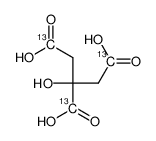302912-06-7
| Name | 2-hydroxypropane-1,2,3-tricarboxylic acid |
|---|---|
| Synonyms |
MFCD01321401
Citric acid-1,5-13C2 |
| Description | Citric acid-13C3 is the 13C labeled Citric acid[1]. Citric acid is a natural preservative and food tartness enhancer. Citric acid induces apoptosis and cell cycle arrest at G2/M phase and S phase in HaCaT cells. Citric acid cause oxidative damage of the liver by means of the decrease of antioxidative enzyme activities. Citric acid causes renal toxicity in mice[2][3][4]. |
|---|---|
| Related Catalog | |
| In Vitro | Stable heavy isotopes of hydrogen, carbon, and other elements have been incorporated into drug molecules, largely as tracers for quantitation during the drug development process. Deuteration has gained attention because of its potential to affect the pharmacokinetic and metabolic profiles of drugs[1]. |
| References |
| Density | 1.762g/cm3 |
|---|---|
| Molecular Formula | C6H8O7 |
| Molecular Weight | 195.10100 |
| Exact Mass | 195.03700 |
| PSA | 132.13000 |
| Index of Refraction | 1.575 |
| Symbol |

GHS05 |
|---|---|
| Signal Word | Danger |
| Hazard Statements | H315-H318 |
| Precautionary Statements | P280-P305 + P351 + P338 |
| Hazard Codes | Xi |
| Risk Phrases | R41;R37/38 |
| Safety Phrases | S26;S36 |
| RIDADR | NONH for all modes of transport |
